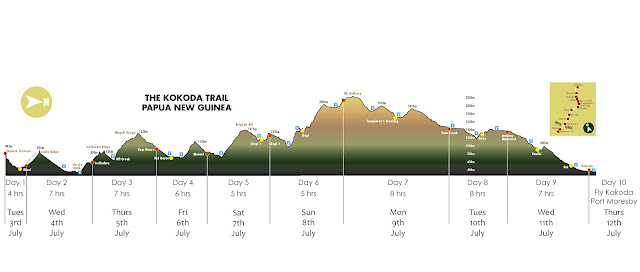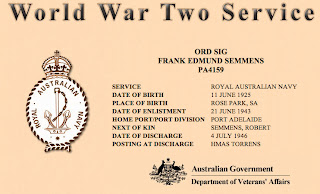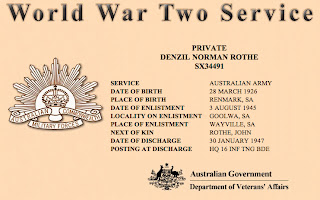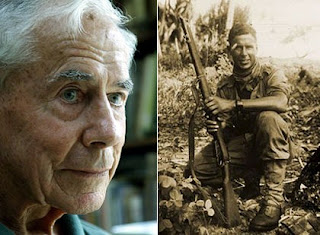 |
| Click on map to enlarge |
Day 1 – Port Moresby – Good Water Camp/Dump 66
Today we travel by road from Port Moresby via the Bomana War Cemetery to pay our respect to the fallen soldiers. We then travel to Sogeri where there is a white stone monument marking the beginning of the Kokoda Trail. Our road journey then takes us to McDonald’s Corner, this is where “B” company of the 39th Battalion commenced their walk to Kokoda and then onto the North Coast area. “B” company was led by Captain Sam Templeton and guided by Bert Kienzle. They departed McDonald’s Corner on July 7 1942 and arrived in Kokoda July 15 1942. We continue to Owers’ Corner with an air of excitement and apprehension for the journey ahead. There is time to relax along the road and take photographs of the spectacular scenery.
On our arrival at Owers’ Corner we make final checks and preparations for the trek ahead and meet our personal porters. Owers’ Corner was also the place where our Australian troops first received the morale boosting artillery support from the gunners. Three 25 pound guns were positioned on the ground and fired 800 rounds over three days into Ioribaiwa Ridge, where the Japanese made their last big push; it took 25 seconds for the projectiles to cover the 15miles across Imita Ridge into Ioribaiwa.
Our troops also dragged down the hill one of the 25 pound guns across Goldie River and up towards Imita Ridge. Have a look for the original zig zag track cut along the way which wound its way down the ridge and up towards Imita Ridge. We start the Kokoda Track with a steep descent down to the Goldie River. The trail crosses the Goldie River and past the abandoned village of Uberi. The first camp is deep jungle, in an old wartime campsite location of Dump 66 at the foot of Imita Ridge. Dump 66 was a major supply/logistic area and also had a medical aid post.
Overnight Dump 66
Day 2 - Good Water Camp/Dump 66 – Ioribaiwa
The first full day of the Kokoda Trail walk includes the ascent up Imita Ridge. Although this is not the steepest or the highest of the mountains along the trail, it will give you an indication of things to come. We stop on top of Imita Ridge and soak in the atmosphere of the place. Imita Ridge was our last line of defence, the line was drawn in the sand here, there was to be no further withdrawal. There was a set of ‘Golden Stairs’ on both sides of Imita Ridge and up towards Ioribaiwa Village. It is important to remember across the Kokoda Track that there was more then one set of Golden Stairs. We descend down Imita Ridge into the beautiful Ua-Ule Creek area (Pronounced Fa-Lay).Here we take our boots off and put on our adventure sandals to cross the creek 22 times. After the creek crossings we put our boots back on and make our final ascent for the day up the gruelling Ioribaiwa Ridge. You will now know that all that training was now worthwhile. Our walk today finishes at the Village of Ioribaiwa.
Overnight Iorabaiwa
Day 3 - Ioribaiwa – Nauro
We have an early start today as we leave Ioribaiwa Village and make our climb up to the top of Ioribaiwa Ridge. This is the furthest spot that the Japanese made across the Kokoda Track, before being ordered to advance to the rear back to Buna. From this point on the ridge the Japanese could see the lights of Port Moresby. Ioribaiwa Ridge was also the spot where our artillery was pounding the Japanese and the scene of bloody fighting. There is also a series of both Australian and Japanese trenches in this area. Our journey takes us down towards Ofi Creek which was the scene of a very successful Australian ambush on the Japanese. Our journey across the Kokoda Trail see us climb one of the most difficult and tiresome sections of the track up and over the Maguli Range to the village of Naoro this is a long climb up that appears to never end. Naoro is another village we see in our travels and is a very pretty place. On the way up there is a concealed Japanese trench system at the Japanese camp where the Japanese mountain gun was being used to pound the Australians on Ioribaiwa Ridge. We camp at Nauro.
Overnight Nauro Village
Day 4 - Nauro – Menari
After breakfast we continue our trek through the swamps of Nauro. This area was also used for aerial drops or biscuit bombing. This area is very swampy and hard going after rain. We cross the fast flowing Brown River before walking through Agulogo on our way to “the wall.” “The Wall is a steep hard climb that takes us to the Menari Gap with views across to Brigade Hill. We have a steep descent down to Menari Village. In the Village is an old Fuzzy Wuzzy Faole, we stop and chat and hear about is stories of the war. Menari is also the village that the Commanding Officer of the 39th Battalion Lt Col Ralph Honner immortalised the 39th Battalion with the Ragged Bloody Heroes photo taken by legendary Australian Photographer Damien Parer. We spend the afternoon relaxing and enjoying the sights and atmosphere of Menari.
Overnight Menari Village
Day 5 - Menari – Efogi 2
Today we have a long tiring climb up to Brigade Hill. Brigade Hill and Mission Ridge was the scene of a major battle 6-8 September 1942 where 101 Australian Soldiers lost their lives.
At Brigade Hill we stop and discuss the battle on Brigade Hill and Mission Ridge before participating in our commemoration service to pay our respects to the soldiers who served us so gallantly during this battle.
We now descend down from Brigade Hill and stop at Nishimura’s stump. Nishimura is the Japanese soldier who pledges to recover the remains of his deceased comrades. He is known as the “Bone Man”.
Our journey continues past the Mission Ridge turnoff. The scenery along this part of the track is spectacular, with views to Mt Bellamy and Kagi. We walk through the Village of Efogi before commencing our steep but short walk up to Efogi 2. From Efogi 2 we have spectacular views across the valley to Mt Victoria.
Overnight Efogi 2
Day 6 – Efogi 2 – 1900
After an early breakfast we commence our descent down from Efogi 2 before commencing a hard climb up to Naduri. Naduri is the Village where one of the last Fuzzy Wuzzy lives Ovuru Ndiki. Ovuru loves sharing his stories about his war experiences.
We continue our climb up towards the moss forests of Mt Bellamy and we trek towards camp takes us through an ancient Arctic beech forest with magnificent giant pandanus and beech trees.
Overnight 1900 Camp
Day 7 – 1900 – Eora Creek (approx. 8 hours)
Today is a great day on the track as we cross the highest point of the track at 2190m. The scenery is spectacular as we cross down through Templeton’s 1 and along the Eora Creek to Templeton’s 2 for lunch. After lunch we have a 3 hour walk through some very pretty country before arriving at our camp Eora Creek. The area from Templeton’s 1 down to Eora Creek was the scene of major battles both during our fighting withdrawal and our advance across the track. We stop along the way to inspect the weapon pits and defensive positions.
Overnight Eora Creek
Day 8 – Eora Creek- Isurava Village
Today after breakfast we cross Eora Creek and make our way up to the Japanese defensive positions on the lower “Lost Battlefields” We view the Japanese mountain gun shells and other left over armaments. This area was the last major fight during the battles on the Kokoda Track. The Japanese fell back to Oivi and Gorari and left the Australians to re occupy Kokoda unopposed.
We continue our climb up to Alola village, Alola is a spectacular village perched on top of the ridge with stunning views down to the Eora Creek Valley and across to Abuari. Alola was also the Headquarters for Brigadier Potts during the battle of Isurava. After morning tea we continue our journey onto the Isurava Battlefields passing by the Isurava Rest house area, Surgeons rock and the area the Butch Bisset passed away.
At the Isurava memorial we have time to visit and inspect the battle sites and reflect on the heroic deeds performed by our boys. After our battlesite briefing we hold our memorial service near Kingsbury Rock before group photos are taken. We then continue our Journey down to the Isurava Village.
Overnight Isurava Village.
Day 9 – Isurava Village - Kokoda
Today is a very exciting day for all the trekkers and porters as we descend down from Isurava to Deniki. At Deniki we can see our final destination Kokoda. Deniki was also a defensive position of the Australians during our fighting withdrawal back from Kokoda. From Deniki we descend down to the beautiful village of Hoi for a refreshing swim and the realisation that you are now off the mountain.
It is now a fast walk to Kokoda and the realisation that you have achieved your dream.
We inspect the battlesite of Kokoda and discuss the actions that took place in the area.
Tonight we overnight in Kokoda.
Overnight Kokoda
Day 10
This morning we have an early morning flight back to Port Moresby and then return to our Hotel for a welcome shower and refreshments.
Overnight Gateway Hotel







.jpg)
.jpg)









